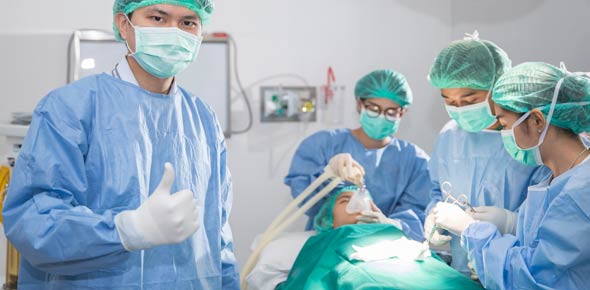Which procedure is followed if the scrub is pricked with a needle?
Which of the following uses ultrasonic energy to fragment the lens in...
A perforated eardrum is corrected by
Which of the following medications would be used as a topical...
A surgical schedule would describe the procedure to treat acute otitis...
Irrigation is used with the ear drill
After the anterior pillar of a tonsil is incised with a #12 blade, the...
When local anesthetic is passed to the surgeon
What is the most effective barrier to stop laser energy from...
A forceps used in nasal surgery is a (n)
Marsupialization of a Bartholin cyst involves the
Syndactyly refers to
Injection of anesthetic solution into the base of the eyelids or...
A solution used for eye irrigation is
A sponge used in brain surgery is a (n)
A method of applying dressings to an unstable area, such as the face...
What procedure is done for chromic dacrocystitis?
Bulky dressings added to the intermediate layer of a three-layer...
A graft containing epidermis and only a portion of the dermis is...
What bandage effects the process of exsamguination of a limb prior to...
In myringotomy, the tube to facilitate drainage is placed into the...
Facial nerve trauma can be decreased by use of
What is the most commonly used donor tendon for a free flexor tendon...
Endoscopic visualizaion of the uterine cavity is called
An item used for padding that has smooth and clingy layers is called
Which dressing is used after nasal surgery?
A safer alternative laser retardant endotracheal tube used for CO2...
Opacity of the vitreous humor is treated by performing a
Which surgery requires an incision under the upper lip above the...
Adherent, occlusive dressings that are used when slight or no drainage...
A benign tumor arising from the eighth cranial nerve, which may grow...
A procedure to treat retinal detachment is
A drug used as a lubricant and as vesicoelastic support to maintain...
What procedure cannot be performed through a pelviscope?
Removal of the entire eyeball is
Nasal polyps are removed with either a polyp forceps or a (n)
The most common topical anesthetic agent used in ENT surgery is
Which medication is found on a tracheostomy setup to reduce the...
Which of the following endotracheal tubes can prevent a fire
Free jejunal tissue transfers are frequently successful as adjunct...
A sponge that is cotton-filled gauze with a cotton thread...
What topical anesthetic is used most frequently for preoperative...
A continuous suture placed beneath the epidermal layer of the skin in...
Colorless prep solution may be indicated for
A trifurcate neck incision is done for a (n)
Cholesteatoma is treated by doing a
A synthetic local anesthetic that is effective on the mucous membrane...
What mode would be utilized to maintain drainage postoperatively in...
A dressing that is held in place by long suture ends criss-crossed and...
To establish a tracheostomy, a midline incision is created in the...
Dilating eye drops are called
Another name for submucous resection is
What procedure accomplishes correction of myopia?
Extrauterine disease of the female reproductive system may utilize any...
Facial nerve decompression is designed to identify an area of...
A progressive disease of the palmar fascia is termed
Miocol solution is prepared for a cataract procedure no more than...
When using a sterile syringe, the scrub nurse should
In cochlear implantation, the receiver is placed into which bone of...
A fleshy, trriangular encroachment onto the cornea is surgically...
A face lift is termed a
All of the following statements regarding the preparation for a skin...
Which position is used following a tonsillectomy?
A surgical treatment for chronic wide angle closure glaucoma that...
A temporary biologic dressing is
Which of the following is NOT a reason for a pressure dressing?
A noninvasive process to treat glaucoma by means of a slit lamp is a...
Lesion of the larynx and vocal cords can be addressed surgically using...
The majority of benign salivary gland tumors occur in which gland?
In cataract surgery, a vesicoelastic drug sometimes used to occupy...
What is the instrument used to effect removal of the septal cartilage...
An enzymatic drug commonly used with anesthetic solutions to increase...
Microtia refers to
The drug added to a local ophthalmic anesthetic to increase diffusion...
Endometrial ablation is performed to correct
Which of the following is the LEAST desirable method for needle...
Removal of a portion of an ocular muscle with reattachment is called
All of the following rules cover handling of prosthetic devices during...
Total laryngectomy includes all of the following EXCEPT
Molteno implants are used surgically to reduce intraocular pressure...
Severe vertigo may be relieved by
What eye disease uses the argon slit lamp with a noninvasive...
A drug used to contract the sphincter of the iris during an...
A miotic drug is
What is the self-retaining retractor used in vaginal procedures?
A procedure performed when the cornea is thickened or opacified is...
A chalazion is a chronic inflammation of the
Sagging and eversion of the lower lid is
When a tracheostomy tube is inserted, the obturator is quickly removed...
Good contact between a skin graft and the recipient site is...
A penile defect in which the urethra ends on the ventral surface of...
Surgical correction of a deviated septum is known as a (n)
Which degree endoscope is used ONLY in maxillary sinus surgery?
What is the proceduce used to correct accidental vitreous loss during...
Which sinus is entered during an intranasal antrostomy (antral...
The intraoperative use of bone allografts requires all of the...
Which of the following hyperosmotic drugs is given preoperaticely...
During ear surgery, pledgets generally used to control bleeding are...
Middle ear ventilation is facilitated by
What combination of lasers are particularly useful in surgery of the...
















